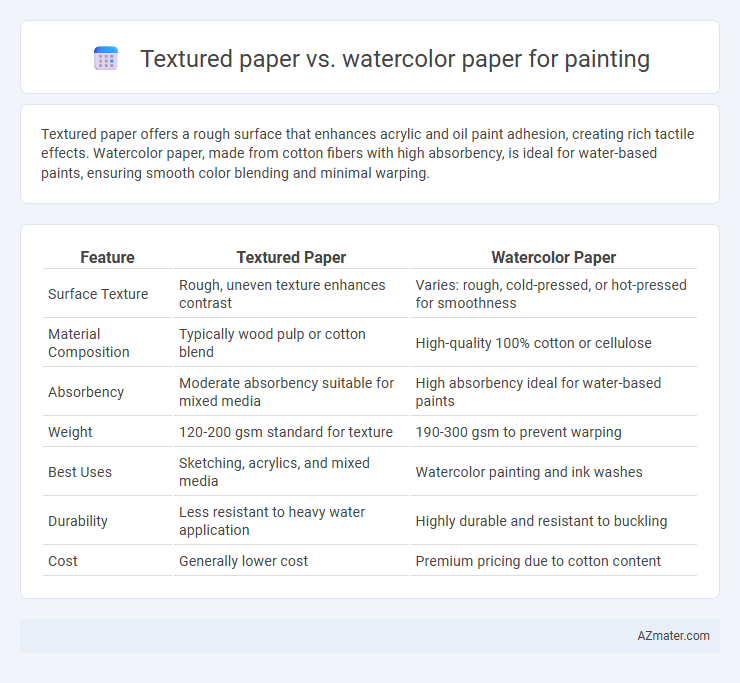Textured paper offers a rough surface that enhances acrylic and oil paint adhesion, creating rich tactile effects. Watercolor paper, made from cotton fibers with high absorbency, is ideal for water-based paints, ensuring smooth color blending and minimal warping.
Table of Comparison
| Feature | Textured Paper | Watercolor Paper |
|---|---|---|
| Surface Texture | Rough, uneven texture enhances contrast | Varies: rough, cold-pressed, or hot-pressed for smoothness |
| Material Composition | Typically wood pulp or cotton blend | High-quality 100% cotton or cellulose |
| Absorbency | Moderate absorbency suitable for mixed media | High absorbency ideal for water-based paints |
| Weight | 120-200 gsm standard for texture | 190-300 gsm to prevent warping |
| Best Uses | Sketching, acrylics, and mixed media | Watercolor painting and ink washes |
| Durability | Less resistant to heavy water application | Highly durable and resistant to buckling |
| Cost | Generally lower cost | Premium pricing due to cotton content |
Introduction: Understanding Textured vs Watercolor Paper
Textured paper features a rough surface with varied patterns that enhance the tactile quality and visual depth of mixed media artwork. Watercolor paper, specifically designed for wet media, typically has a higher weight and a consistent cold-pressed or rough finish to absorb water and pigment effectively without warping. Choosing between textured paper and watercolor paper depends on the painting technique, desired texture, and medium compatibility for optimal artistic results.
Key Characteristics of Textured Paper
Textured paper features a rough surface with pronounced tooth, which holds pigment effectively and allows for dynamic brushwork and layering techniques. Its absorbency varies, providing a tactile quality ideal for acrylics, oils, and mixed media where texture enhances visual depth. Compared to watercolor paper, textured paper typically offers less water absorption but superior grip, making it suitable for bold, textured paint applications.
Unique Qualities of Watercolor Paper
Watercolor paper stands out due to its superior absorbency and durability, designed specifically to handle wet media without warping or bleeding. Its textured surface, often cold-pressed or rough, enhances pigment granulation and allows for varied brush techniques, creating depth and vibrant color transitions. Unlike standard textured paper, watercolor paper maintains its integrity through multiple washes and layering, making it ideal for intricate, water-based painting methods.
Surface Comparison: Texture and Feel
Textured paper offers a pronounced surface with raised patterns that enhance paint adhesion and create tactile visual effects, ideal for mixed media and expressive brushwork. Watercolor paper features a specifically designed absorbent texture, available in hot-pressed (smooth), cold-pressed (medium texture), or rough varieties that optimize water flow and pigment dispersion for watercolor techniques. The choice between textured and watercolor paper significantly influences the paint application, drying behavior, and final artwork appearance, making surface texture and feel crucial factors in selection.
Absorbency and Paint Handling Differences
Textured paper features a rough surface that enhances paint absorbency, allowing pigments to settle into the grooves for varied tonal effects, ideal for expressive, layered applications. Watercolor paper, specifically designed with high absorbency and a durable sizing layer, controls water flow, preventing over-saturation and enabling smooth blending and lifting techniques. The differences in absorbency and surface texture significantly influence paint handling, where textured paper creates more granulation and texture, while watercolor paper offers precision and fluidity in color transitions.
Suitability for Various Painting Mediums
Textured paper offers a rough surface ideal for acrylics and oils, allowing paint to grip and layers to build, enhancing depth and texture in artwork. Watercolor paper, specially designed with absorbent fibers and often cold-pressed or rough, excels in holding water-based paints without warping, making it perfect for delicate watercolor techniques and washes. Each paper type supports different mediums uniquely: textured paper supports thick, heavy applications, while watercolor paper handles fluid, translucent layers efficiently.
Effects on Color Vibrancy and Blending
Textured watercolor paper enhances color vibrancy by allowing pigments to settle into the paper's natural tooth, creating rich, dynamic hues and depth. The texture promotes subtle color blending and layering effects, producing smooth transitions and soft gradients for detailed artwork. In contrast, textured paper designed for general crafts lacks the absorbency and surface structure needed for watercolor pigments, resulting in less vibrant colors and more difficulty achieving seamless blending.
Durability and Paper Weight Considerations
Watercolor paper offers superior durability due to its heavier weight, typically ranging from 190 to 300 gsm (grams per square meter), which prevents warping and withstands repeated washes. Textured paper varies widely in weight, often lighter and less durable, making it more prone to buckling under heavy paint or water application. Choosing watercolor paper ensures better structural integrity for longevity and a professional-quality finish in painting projects.
Cost and Availability of Each Paper Type
Textured paper is generally more affordable and widely available at local art supply stores, making it a budget-friendly option for beginners and casual painters. Watercolor paper, especially high-quality cotton varieties, tends to be more expensive due to its specialized manufacturing process and thicker weight, but it is essential for professional watercolor techniques and durability. Both types have multiple size options, but textured paper offers a broader range of economical choices compared to premium branded watercolor papers often found in specialty shops or online.
Choosing the Right Paper for Your Art Style
Textured paper offers pronounced surface patterns ideal for artists seeking to enhance their work with tactile effects, particularly in dry media like charcoal or pastel. Watercolor paper, commonly made from cotton and available in hot-pressed, cold-pressed, or rough textures, provides superior water absorption and durability suitable for washes and blending in watercolor painting. Choosing the right paper depends on your medium and desired effect: textured paper emphasizes surface detail for dry techniques, while watercolor paper supports fluid, translucent washes with controlled pigment flow.

Infographic: Textured paper vs Watercolor paper for Painting
 azmater.com
azmater.com